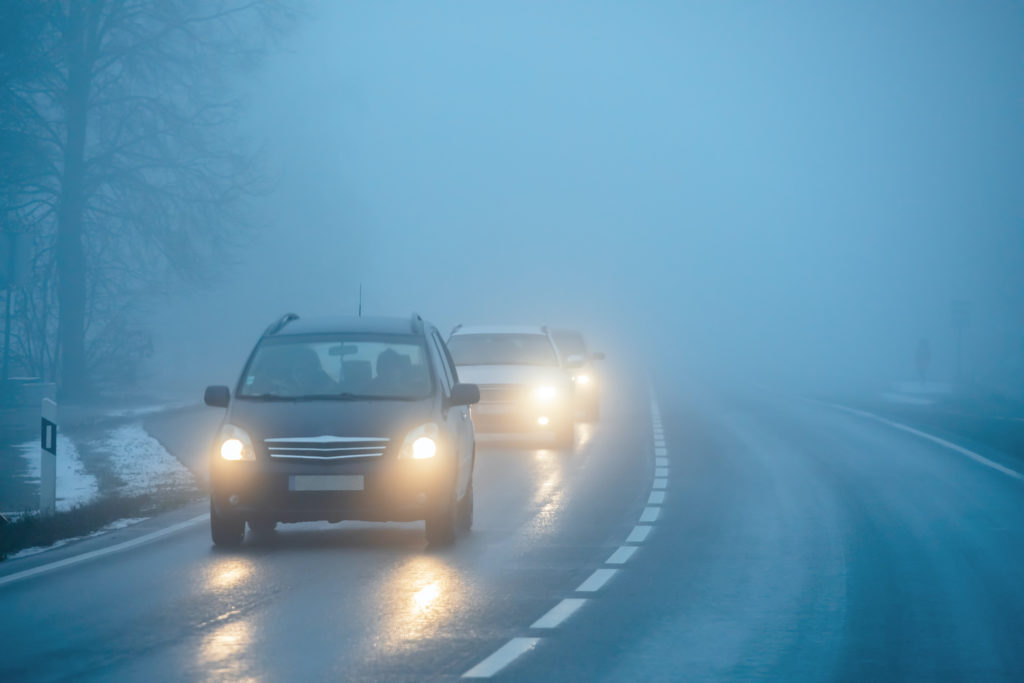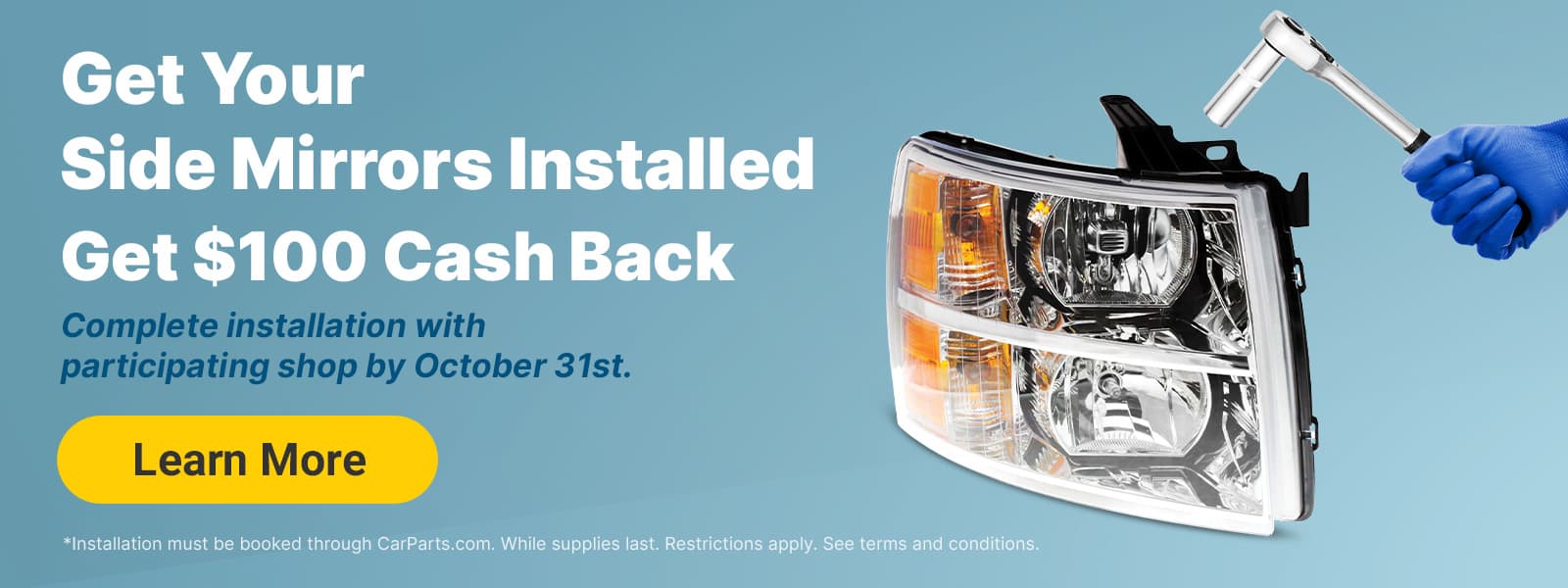Headlights are designed to improve visibility on the road when driving under low-light conditions. Using them is crucial, not only to ensure your safety and prevent accidents but also to avoid legal troubles in various states.
In this article, we’ll talk about the instances when you must use headlights, including social situations (yes, you can communicate with other people using your headlights), state-specific conditions, and practical functions.

When to Use Headlights
Headlights are essential tools for visibility. Most people use them only at night, but there are other instances when they can help you improve your experience on the road. Here are the instances when you should turn on your headlights:
Nighttime
Driving with your headlights on at night is crucial to ensure the safety of not only you and your passengers, but also the pedestrians and drivers around you.
At what specific time at night should you use your headlights? The answer will differ depending on what state you live in, but most state laws will require you to turn your headlights on 30 minutes after sunset.
Note: At night, a driver should dim his headlights when an oncoming motor vehicle comes within 500-700 feet.
Bad Weather
Headlights should be activated when visibility is low, and one example is during inclement weather.
This is the most common use of your headlights during the daytime. After all, low visibility doesn’t only happen at nighttime; it also pertains to any point or situation that impairs your vision, such as when it is cloudy, foggy, raining, or snowing.
Laws on headlights differ among states, but most require you to turn on your headlights if the weather forces you to use your windshield wipers.
Use your low beam headlights during such instances. High beams can reflect light back to you during adverse weather conditions and cause glare, which can compromise your vision.
To Make Other Drivers Aware of Your Presence
When you are traveling through mountain and rural roads, it is highly recommended that you keep your headlights on. This will help you counter the limited visibility and dangerous driving conditions brought about by narrow roads or uneven terrain.
The light will make it easier for other drivers to spot you from a distance.
Flashing your headlights under certain conditions will also help you get the attention of another driver who may not be aware of your presence.
Daytime Headlight Zone
According to the Department of Motor Vehicles, you should also turn on your headlights when passing by roads with signs that say, “Daytime Headlight Zone”, or something similar.
You’ll usually find these types of road signs on busy highways that are prone to traffic accidents.
There may be other functions of headlights that get hyped in box office hits. However, copying those stunts can be dangerous and must not be your goal in driving. Otherwise, you may endanger not only your life but also the lives of the people around you.

Headlight Use Laws Across the US
Almost every state implements its own laws regarding headlight use. The regulations can include everything from the exact time you should start using your headlights after sunset to the various weather conditions that require their use.
Because of the number of unique, state-specific headlight regulations, it can be difficult to remember all of them. Here’s a quick guide to the various headlight use laws across the US:
| State | Turn on your headlights… |
|---|---|
| Alabama | When visibility is less than 500 feet When using your wipers 30 minutes after sunset 30 minutes before sunrise |
| Alaska | When your speed exceeds 45 mph on designated highways When visibility is less than 500 feet |
| Arizona | When visibility is less than 500 feet From sunset to sunrise |
| Arkansas | When visibility is less than 500 feet When using your wipers ½ hour after sunset to ½ hour before sunrise |
| California | When visibility is less than 1,000 feet When using your wipers continuously During darkness |
| Colorado | When visibility is less than 1,000 feet Between sunset and sunrise |
| Connecticut | When visibility is less than 500 feet During conditions of adverse weather or insufficient light ½ hour after sunset to ½ hour before sunrise |
| Delaware | When visibility is less than 1,000 feet When using your wipers From sunset to sunrise |
| District of Columbia | When visibility is less than 500 feet When using your windshield wipers When going through tunnels ½ hour after sunset to ½ hour before sunrise |
| Florida | From sunset to sunrise During conditions of adverse weather or insufficient light |
| Georgia | When visibility is less than 500 feet During conditions of adverse weather or insufficient light ½ hour after sunset to ½ before sunrise |
| Hawaii | ½ hour after sunset to ½ hour before sunrise |
| Idaho | When visibility is less than 500 feet From sunset to sunrise |
| Illinois | When visibility is less than 1,000 feet When using your wipers From sunset to sunrise |
| Indiana | When visibility is less than 500 feet From sunset to sunrise *You must only use white or amber headlights. |
| Iowa | When visibility is less than 500 feet During conditions of adverse weather or insufficient light From sunset to sunrise |
| Kansas | When visibility is less than 1,000 feet When using your windshield wipers continuously to counter rain, sleet, or snow During unfavorable atmospheric conditions (including fog or smoke) as well as insufficient light From sunset to sunrise |
| Kentucky | *You must use high beams only at 350 feet or greater and low beams at 100 feet |
| Louisiana | When visibility is limited to 500 feet When using your wipers During unfavorable atmospheric conditions as well as insufficient light From sunset to sunrise |
| Maine | When visibility is less than 1,000 feet When using your wipers During conditions of adverse weather or insufficient light ½ hour after sunset to ½ hour before sunrise |
| Maryland | When visibility is less than 1,000 feet When using your wipers |
| Massachusetts | When visibility is limited to 500 feet due to atmospheric conditions, such as fog, rain, and snow When using your wipers ½ hour after sunset to ½ hour before sunrise |
| Michigan | When visibility is less than 500 feet ½ hour after sunset to ½ hour before sunrise |
| Minnesota | During conditions of adverse weather or insufficient light that limits visibility to 500 feet During rain, snow, sleet, or hail From sunset to sunrise |
| Mississippi | When visibility is less than 500 feet From sunset to sunrise |
| Missouri | When visibility is less than 500 feet During weather conditions that require the use of windshield wipers to drive safety, including fog ½ hour after sunset to ½ hour before sunrise |
| Montana | When visibility is less than 500 feet During conditions of adverse weather or insufficient light ½ hour after sunset to ½ hour before sunrise |
| Nebraska | When visibility is less than 500 feet From sunset to sunrise |
| Nevada | When visibility is less than 1,000 feet ½ hour after sunset to ½ hour before sunrise |
| New Hampshire | When visibility is less than 1,000 feet During inclement weather ½ hour after sunset to ½ hour before sunrise |
| New Jersey | When visibility is less than 500 feet When using your wipers During conditions of adverse weather or insufficient light |
| New Mexico | When visibility is less than 500 feet ½ hour after sunset to ½ hour before sunrise |
| New York | When visibility is less than 1,000 feet When using your wipers During adverse weather or insufficient light ½ hour after sunset to ½ hour before sunrise |
| North Carolina | When visibility is limited to 400 feet due to insufficient light When using your windshield wipers From sunset to sunrise |
| North Dakota | When visibility is less than 1,000 feet During adverse weather or insufficient light From sunset to sunrise |
| Ohio | When visibility is less than 1,000 feet During conditions of adverse weather or insufficient light When using your wipers From sunset to sunrise |
| Oklahoma | When visibility is less than 1,000 feet During conditions of adverse weather or insufficient light ½ hour after sunset to ½ hour before sunrise |
| Oregon | When visibility is less than 1,000 feet From sunset to sunrise |
| Pennsylvania | When visibility is less than 1,000 feet When using your wipers When going through construction zones During conditions of adverse weather or insufficient light From sunset to sunrise *Remove snow and ice from your vehicle before driving. |
| Rhode Island | When visibility is less than 500 feet When using your wipers During conditions of adverse weather or insufficient light From sunset to sunrise |
| South Carolina | When visibility is less than 500 feet When using your wipers ½ hour after sunset to ½ hour before sunrise |
| South Dakota | When visibility is less than 200 feet ½ hour after sunset to ½ hour before sunrise |
| Tennessee | When visibility is less than 200 feet During rain, fog, or smoke ½ hour after sunset to ½ hour before sunrise |
| Texas | When visibility is less than 1,000 feet During nighttime |
| Utah | When visibility is less than 1,000 feet During conditions of adverse weather or insufficient light |
| Vermont | When visibility is less than 500 feet During conditions of adverse weather or insufficient light ½ hour after sunset to ½ hour before sunrise |
| Virginia | When visibility is less than 500 feet When using your wipers From sunset to sunrise |
| Washington | When visibility is less than 1,000 feet ½ hour after sunset to ½ hour before sunrise |
| West Virginia | When visibility is less than 500 feet During conditions of adverse weather or insufficient light From sunset to sunrise |
| Wisconsin | During hours of darkness During period of limited visibility, unless you have daytime running lights |
| Wyoming | When visibility is less than 1,000 feet During conditions of adverse weather or insufficient light ½ hour after sunset to ½ hour before sunrise |
Do’s and Don’ts for Vehicle Lights
Here is a simple rundown on what you should and should not do while using your headlights and other vehicle lights on the road:
Do: Ensure your headlights (and all other lights) are functional before you drive.
Don’t: Drive without checking if key safety features of your vehicle are working.
Do: Make it a habit to turn your headlights off after a long drive.
Don’t: Forget to turn your headlights off overnight. This can drain your car’s battery and render it useless in the morning. Your car’s alternator only works when the engine is running.
Do: Get used to your headlight’s range, brightness, and accessibility.
Don’t: Drive your car without becoming familiar with its light fixtures and other features.
Do: Use your hazard lights conservatively, and only in times of real hazards.
Don’t: Abuse your hazard lights and park in illegal spaces.

Do: Turn on your high beams when you need extra visibility, especially during nighttime, or while driving on a road with multiple twists and turns.
Don’t: Keep your high beams on when vehicles pass on the opposite lane. The brightness of your lights can temporarily blind drivers and cause accidents.
Note: High beam headlights must not be used within 500 feet of oncoming traffic or 200 feet behind another vehicle.
Following this list, using your headlights property, and taking note of state-specific laws will make you a better, safer, and more reliable driver. In parting, the best practices often come with politeness and proper regard for road regulations. Knowing and understanding that you’re not the only driver on the road will allow you to respect and empathize with your fellow drivers.
Any information provided on this Website is for informational purposes only and is not intended to replace consultation with a professional mechanic. The accuracy and timeliness of the information may change from the time of publication.
































